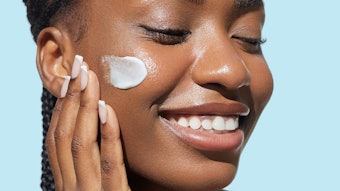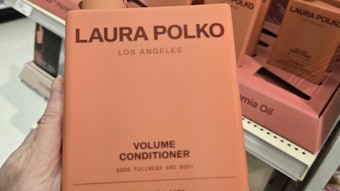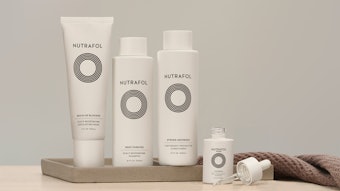
The nano-revolution is in full swing across a broad range of industries, and the personal care industry is benefiting from the immense amount of progress in this area. Some recent hairstyling innovation using nanotechnology and microtechnology are reviewed in this article. These developments range from the lotus effect for frizz control and the development of liquid silk hair fixatives, to micro-segregating tough copolymers and supramolecular structures built from a scaffolding of soluble polymers that are joined together by tiny particles. The personal care industry has revolutionized sunscreens with nanoparticles, and the industry sector is moving apace with developments in this exciting emerging field.
Hydrophobicity for Hair Frizz
A major trend in hairstyling is the control of frizzy hair.1 Hair becomes frizzy when it is exposed to high humidity, and previous technologies for controlling frizz were based upon coating the hair with silicones. Recent products aim to control frizz for an extended period of time without adversely affecting other properties such as appearance, feel, volume, shine and softness.
Avon has approached this challenge by hydrophobically coating the hair with a composite that includes a hydrophobically surface-modified aluminum oxide (ranging from nanometer to micron size), a silicone acrylate film-former and a silicone fluid. In this producta the Avon researchers invoke the “lotus effect,”2 coined from the observation that water droplets ball up on the leaf surface of the lotus flower (Nelumbo). The small particles in the coating impart a surface roughness to the coating , and this enhances its hydrophobicity. The droplets roll off the leaves, taking with them any dirt that may have been deposited and conferring the property of self-cleaning on the leaf surfaces. Water droplets in air are round due to the high cohesion of the water molecules, which is manifested in a high surface tension. When placed on a surface, the forces of cohesion within the water compete with the forces of adhesion to the surface. If the adhesional forces are stronger than the liquid’s cohesion, then the liquid will spontaneously wet the surface and spread. However, if cohesion prevails, droplets will be formed on the surface, and if the contact angle of a water drop is greater than 90 degrees, the surface is characterized as being hydrophobic. Roughening of a hydrophobic surface will enhance the contact angle and the surface will appear to be more hydrophobic than its smooth analogue. Superhydrophobicity results when the surface possesses arrays of nanosize protrusions, as shown in Figure 1.3–5
Styling with Spider Silk
An increased consumer desire for smooth hairstyles has led to hair smoothing claims being emphasized by marketing. Smooth, high-hold fixatives can be achieved by combining VP/methacrylamide/vinylinidazole copolymer with aminosilicones.7 Procter & Gamble researchers have demonstrated that the high-holding capability of a wide variety of polymer fixative resins can be enhanced with photochemical post-crosslinking.8 The desire to make hair soft, smooth and shiny combined with the natural trend has led to the introduction of “liquid silk” as an ingredient that is substantive to hair.9 Spider silk is 10 times more elastic and three times tougher than high performance polyaramid fibers such as a para-aramid synthetic fiberb. However, commercial production of synthetic silk fibers has been limited by two factors: Spiders cannot be mass farmed because of their cannibalistic behavior, and they do not produce large quantities of silk.10, 11
The kind of spider silk that has been most investigated is called major ampullate, or dragline spider silk, which is the one normally used to anchor a web. The impressive mechanical properties of major ampullate spidroin (MaSp1) are due to the hierarchical polypeptide structure, as illustrated in Figure 2. Spider silk is like a block copolymer; it has sections of polyalanine (polyA) blocks and also glycine-rich regions. The ratio of two changes the type of silk. Stretchy silk has more glycine-rich regions and less crystallinity. The mechanical properties of silk may be attributed to the alternation of both polyA and glycine-rich (G-rich) domains in addition to the supramolecular self-assembly of these domains into higher ordered structures.12–15
Silk protein molecules self-assemble in solution17 due to the hydrogen bonding and hydrophobic interaction between their antiparallel beta-pleated sheets.18 These interactions promote film formation, and that property is being used to form films of “liquid silk” on hair to confer both styling and smoothness. There is a wide variety of silk proteins produced by thousands of different species of spiders and insects.19 However, only a few of these proteins have been well characterized. The cocoon silk (silk fibroin) of the silkworm Bombyx mori and the dragline silk of the orb-weaving spider Nephila clavipes have been well studied. Silk from these sources is insoluble and it must be hydrolyzed to render it useful as an ingredient in hair care, but these proteins can now be sourced from recombinant DNA technology, which can produce these proteins by microbial expression.20
Spider silk exhibits super-contraction upon exposure to moisture, and it has been speculated that this prevents the web from sagging and collapsing when wet with rain or dew.21 In this respect, silk displays a stimuli-responsive characteristic that would be useful in hair fixation, as hairstyles flatten in humid conditions. When dragline silk is spun, the molecules in the glycine-rich region are extended and “fixed” by hydrogen bonds between the molecular strands. This ordered, extended conformation has reduced conformational entropy. Upon exposure to moisture, water molecules compete for and sever the hydrogen bonds, and the silk “entropy spring” retracts, as pictured in Figure 3.22 Alas, the highly ordered structures seem to be formed during the spinning process. Perhaps someday, the spinnerets (spinning organ) of spiders will be emulated to form silk hairsprays that maintain hairstyles regardless of the level of humidity.
In an age when inkjet printers have been developed to selectively cover skin blemishes,23 the development of spinneret applicators for hair fixative compositions may not be far away. Indeed, some researchers are already spinning, electrospinning and centrifuge spinning recombinant spider silk to obtain fibrous, sheet-like structures.24
Macromolecular Compatibility and Controlled Segregation to Confer Multifunctionality
The styling hold of strong-holding hairstyles is determined primarily from the type and amount of styling polymer used. For strong-hold, humidity-resistance, low stickiness and high manageability are necessary. A reasonable degree of conditioning is also desirable. There is a trend to move toward fixative polymer blends to achieve the high hold without compromising other aesthetics. For example, these properties have been achieved by combining amphipathic cationic polymers with chitosan as a stabilizer to maintain homogeneity in the formulation and to produce the desired rheology for application.25 Blending polymers to form a film is not straightforward because the entropy of mixing is small and thus, in the absence of strong enthalpic interactions, segregation of the two polymeric components often occurs as solvent evaporates. This is especially the case for stiff-backboned polymers such as chitosan. Moreover, chitosan is soluble only in acidic solutions, and this limits the degree of formulation freedom to prepare a blend of water-soluble, fixative macromolecules that will resist moisture.
Polymers do not mix well molecularly, and as the number of polymers in a formulation increases, the probability of finding a compatible composition decreases. However, researchers26 have managed to create stable, high-hold formulations that contain two distinct copolymers. The polymers are acrylates/C1-2 succinate/hydroxyacrylates copolymer and octylacrylamide/acrylates/butylaminoethyl methacrylate copolymer. These formulations retain flexibility, elasticity and plasticity.
The entropic demixing of polymers is used advantageously in block copolymers. In this case, the dissimilar blocks are covalently bound to each other, and through micro/nanophase separation, the phases can be self-assembled into a variety of precise structures, each with distinct mechanical, optical and solubility characteristics.27 Until recently, the application of this technology to personal care was limited because anionic polymerization was the only available production technology. Anionic polymerization is limited to few monomers, and this severely limited the possible diversity of block copolymers that could be produced for personal care applications. This situation was changed with the introduction of living free radical polymerization, which has broadened the variety of possible block copolymers that can be produced. Block copolymeric, stimuli responsive emulsifiers with film-forming capability are being created for the personal care industry.28
Eastman Chemical has introduced a multifunctional clear gel that is probably a supramolecular micro- or nanocomposite. They achieve this by combining the particulate film-former anionic polyester-5 with the cationic polysaccharide polyquaternium-10. Clear gels are obtained that deliver styling with a soft feel.29
Summary
Controlling structures at the nanoscale can lead to the development of innovative properties for materials used in hairstyling, and this opens the door to new styling opportunities. Arrays of hydrophobic nanoparticles on the surface of hair have been developed to prevent the intrusion of water into the hair and thereby to prevent frizz. Genetically engineered silk analogs are being used to create styling with smooth feel, and as this technology advances, there can be hope for paradoxical properties of hair fixatives, such as strengthening in the presence of moisture to counteract the flattening of hairstyles on humid days. Polymer blends are increasingly being utilized to confer high-hold with good aesthetics. In this instance, polymers are often incompatible due to their low entropy of mixing, and the enhancement of properties by polymer blending is not a straightforward exercise in formulation. Supramolecular assemblies of oppositely charged polymers and particles may lead to the introduction of hair set with soft feel. Nanostructuring of materials offers the promise of revolutionary new products that could overcome the compromise in benefit delivery that is often accepted with conventional materials.
References
1. Advance Techniques Frizz Control Lotus Shield Anti-Frizz Treatment, http://shop.avon.com/shop/search.aspx?department=search7find_spec=frizz (Accessed Sep 29, 2011)
2. US Patent Application 20110110992, Methods and Compositions for Preventing or Reducing Frizzy Appearance of Hair, MS Garrison, FE Robinson, GA Sandstrom, KA Buckridge, S Yang, X Luo, assigned to Avon Products, (May 12, 2011)
3. W Barthlott and N Ehler, Raster-Elektronenmikroskopie der Epidermis-Oberflächen von Spermatophyten, Tropische und subtropische Pflanzenwelt (Akad. Wiss Lit Mainz) 19 110 (1977)
4. US Patent 5,853,894, Laboratory vessel having hydrophobic coating and process for manufacturing same, JF Brown (Issued Dec 29, 1998)
5. O Werner and L Wagberg, The Influence of Geometry on Superhydrophobicity, Smart Coatings II,T Provder and J Baghdachi, eds, ACS Symposium Series 1002 13 250–273 (2009)
6. W Thielicke, Hamburg, published in Wikipedia commons, https://en.wikipedia.org/wiki/Lotus_effect#cite_note-2 (Accessed Sep 29, 2011)
7. US Patent Application 20110110878, Smooth Styling Agents, T Knappe and HV Flodrop, (May 12, 2011)
8. US Patent Application 20110104095, Cosmetic Compositions, A Flohr, TC Kripp and M Morand, (May 5, 2011)
9. http://www.schwarzkopf-consumer.co.uk/index.php?id=6976 (Accessed Sep 29, 2011)
10. C. Vendrely and T. Scheibel, Macromolecular Bioscience 7 401–409 (2007)
11. S Arcidiacono, C Mello, D Kaplan, S Cheley and H Bayley, Applied Microbiology and Biotechnology 49 31–38 (1998)
12. LW Jelinski, Current Opinion in Solid State & Materials Science 3 237–245 (1998)
13. US Patent 7,060,260, Water-soluble silk proteins in compositions for skin care,hair care or hair coloring, SR Fahnestock and TM Schultz, assigned to EI DuPont de Nemours and Company, (Jun 13, 2006)
14. D Porter, F Vollrath and Z Dhao, Predicting the mechanical properties of spider silk as a model nanostructured polymer, Eur Phys J 16 199–206 (2005)
15. M Xu and RV Lewis, Structure of a protein superfiber: spider dragline silk, Proc Natl Acad Sci USA 87 7120–7124 (1990)
16. http://www-users.york.ac.uk/~mal503/common/thesis/c3.html (Accessed Sep 29, 2011)
17. S Winkler et al, Designing recombinant spider silk proteins to control assembly, Int J Biol Macromol 24 265–270 (1999)
18. S Arcidiacono et al, Purification and characterization of recombinant spider silk expressed in Escherichia coli, Appl Microbio Biotechnol 49, 31–38 (1998)
19. RF Foelix, Biology of Spiders, Harvard University Press, Cambridge, MA, USA (1992)
20. US Patent Application 20100298877, Recombinant spider silk proteins,T Scheibel, D Huemmerich and C Ackerschott, Recombinant spider silk proteins, assigned to Amsilk GMBH (Nov 25, 2010)
21. C Boutry and TA Blackledge, Evolution of supercontraction in spider silk: structure-function relationship from tarantulas to orb-weavers, J Exper Biol 213 3505–3514 (2010)
22. PT Eles and CA Michal, Strain dependent local phase transitions observed during controlled supercontraction reveal mechanisms of spider silk, Macromolecules 37 1342–1345 (2004)
23. US Patent Application 20110155161, Methods of treating keratinous material, and apparatus for implementing such methods, H Samain, assigned to L’Oréal (Jun 30, 2011)
24. US Patent Application 20110136669, Continuous fiber layer comprising an active substance on the basis of bio-polymers, the use thereof and method of production thereof, B Liebmann and E Klimov, assigned to BASF (Jun 9, 2011)
25. US Patent Application 20110165109, Agent for fibers containing keratin, comprising at least one specific amphiphilic cationic polymer and at least one additional film-forming and/or stabilizing polymer selected from chitosan and derivates thereof, B Mueller and P Kaftcan, (Jul 7, 2011)
26. US Patent Application 20110064678, Styling agents giving a high degree of hold, T Knappe, S Albrechtsen, U Bergemann, assigned to Henkel AG (Mar 17, 2011)
27. FS Bates and GH Fredrickson, Block Copolymers—Designer Soft Materials, Physics Today 52 32 (1999)
28. P McCarthy, Designed polymers with well-defined polymeric arches: a novel approach to achieving high performance skin sensorics HBA Expo, 2011 www.hbaexpo.com/technical-track-12
29. www.eastman.com/Literature_Center/C/CB67.pdf (Accessed Sep 29, 2011)











